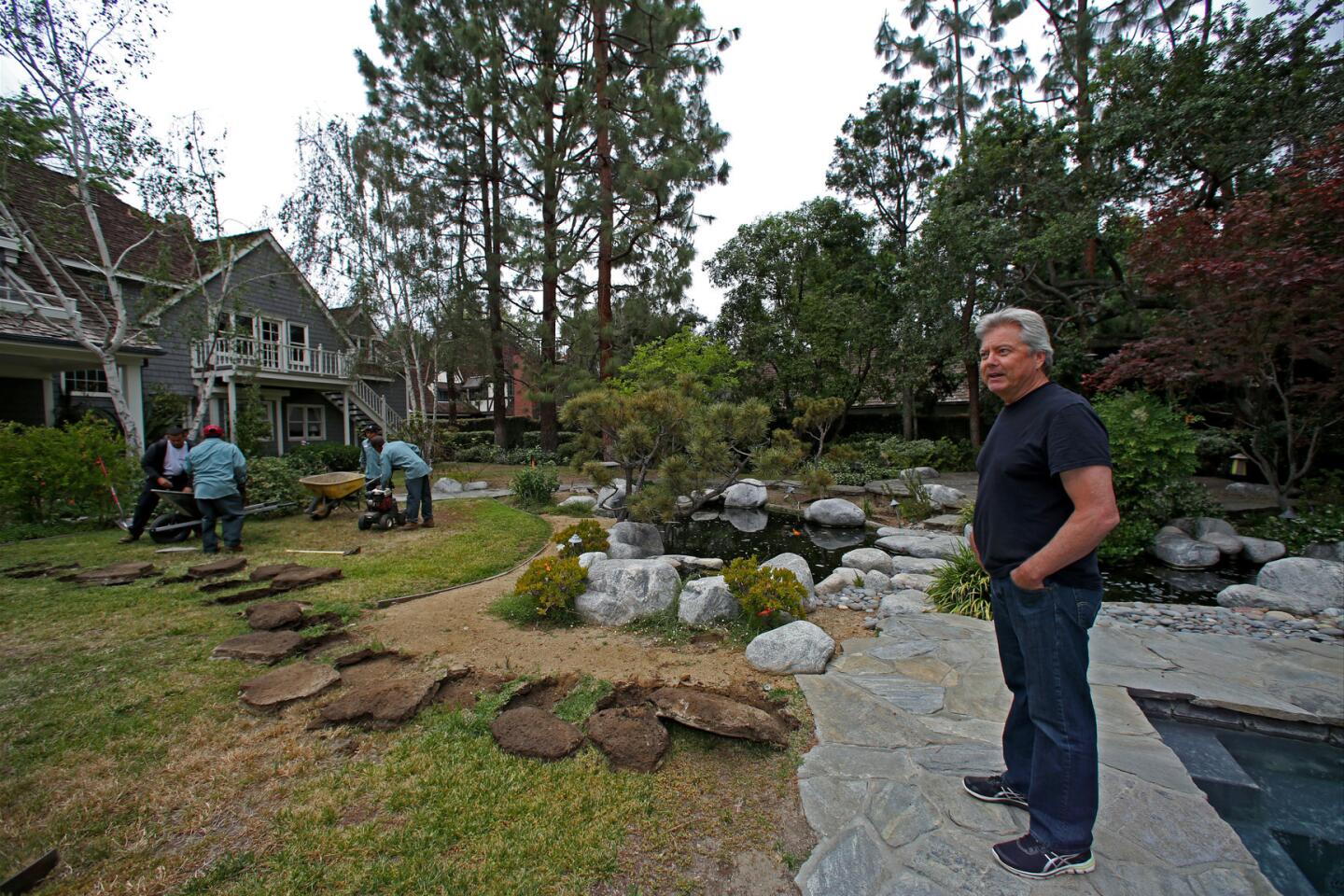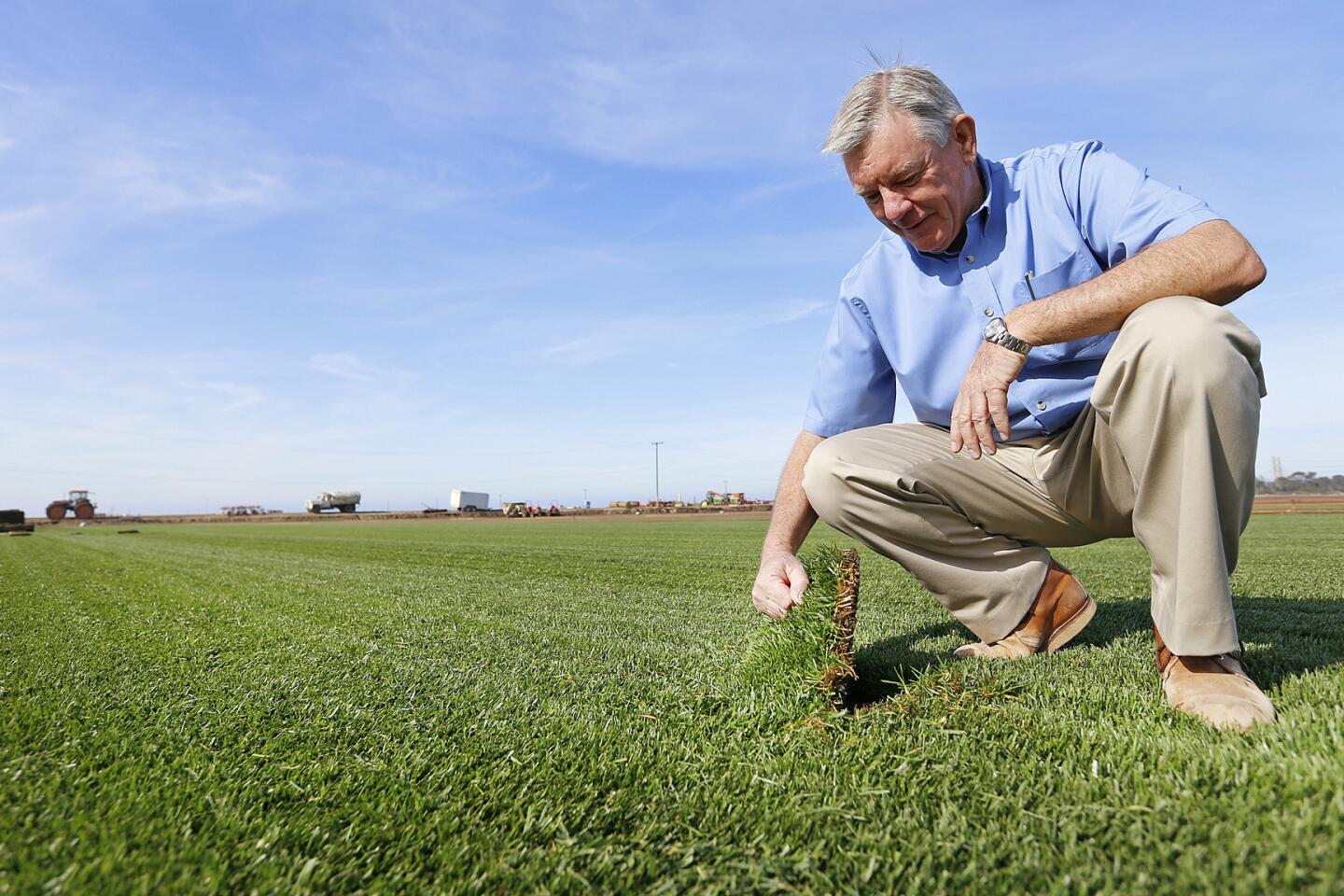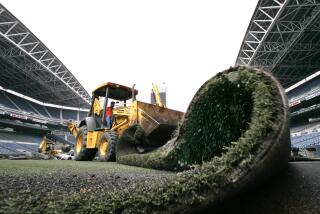Southland saying goodbye to lawns
- Share via
When Gov. Jerry Brown ordered a 25% cut in urban water use, he declared war on the California lawn.
Among the early casualties is the expanse of green that Tom Beck and his wife planted around their Arcadia home 26 years ago.
“I have mixed emotions,” Beck said as he watched a gardening crew scrape up the grass in his backyard and cart it to a truck headed for the green waste dump.
The Becks’ four children grew up playing on the lawn. Their dogs romped on it. They hosted garden parties on it. But “times have changed,” Beck said. Now the Arcadia city councilman is re-landscaping his spacious lot to cut his water-guzzling lawn in half.
Big droughts leave their stamp on California. The 1976-77 drought helped launch the move to low-flow plumbing fixtures. This one may spell the end of the lush lawn that — even more than palm trees or pools — has been the beloved badge of Southern California suburbia for more than half a century.
“The idea of your nice little green grass getting lots of water every day — that’s going to be a thing of the past,” the governor said when he issued his April 1 directive.
Demand for turf removal rebates has exploded since then. In a single week this month, the Metropolitan Water District of Southern California received nearly $49 million worth of requests for conservation rebates, most of them for cash-for-grass subsidies. The agency is considering pumping an additional $150 million into the program. But that clearly won’t be enough, so Metropolitan is warning rebate applicants there is no guarantee of approval.
In all, the Southland is expected to tear out the equivalent of more than 2,100 football fields of grass — or more than twice the turf removal goal Brown set for the entire state in his emergency drought order.
“I think people will look back 10 years from now [and say] that was the period when Southern California started moving away from lawns,” said Jeffrey Kightlinger, Metropolitan’s general manager.
The district, which supplies the region with water from Northern California and the Colorado River, isn’t just trying to get through one of the worst droughts in the state record. It’s attempting to permanently alter the climate-defying face of the Southland.
“We need to be leading a change in behavior,” said Deven Upadhyay, Metropolitan’s water resource manager.
Water in the Southland — first from the Owens Valley, then from the Colorado and from Northern California — was for most of the 20th century cheap and plentiful. Easterners and Midwesterners who streamed into the region could create yards even lusher than those they left behind, oblivious to the fact that they lived in the drought-prone, semiarid West.
“One of the first sounds I associated with waking up in the morning was the clickity-click-whoosh, clickity-click-whoosh of overhead sprinklers watering lawns and gardens,” Southern California gardening guru Pat Welsh wrote, recalling her family’s 1944 move to Los Angeles on her blog last year. “There was something empty and slightly sad about all these abundant gardens with their over-irrigated lawns. Los Angeles didn’t feel real.”
Brent Haddad, director of the Center for Integrated Water Research at UC Santa Cruz, grew up in the San Fernando Valley. Back in the 1970s, he said, Los Angeles could be described as an urban wetland. “I remember fog so thick in the mornings that I couldn’t see my hand in front of my body when I was walking to school — blinding fog that was evaporation of all the irrigation in the morning,” he said.
Since then, major droughts and environmental restrictions on deliveries from the Owens Valley have made Angelenos more water conscious. Despite growth, the city uses less water than it did 45 years ago. But lawns, large and small, still reign supreme in the sprawl of Greater Los Angeles.
The Becks built their two-story, Cape Cod-style house on a big lot in the affluent foothill town of Arcadia in the middle of the 1987-92 drought. Yet it didn’t occur to them to limit grass.
“We wanted a lawn for the kids and dogs. Lawns look good,” said Beck, 63.
It wasn’t until the Becks bought a second home on the chronically water-starved Central Coast a decade ago that he began to think about water.
Then, last year when he was elected to the City Council, he attended a regional workshop for local politicians that included sessions on California’s dwindling water supplies. “The more I learned, the more concerned I got,” said Beck, a retired partner in a Pasadena law firm.
Plans for his garden makeover, spread across his dining room table, call for converting nearly 3,900 square feet of lawn into patios and less thirsty plantings. “I think a lot of people are going to be doing this,” he added.
The Metropolitan Water District estimates that removing one square foot of grass in Southern California saves 42 gallons of water a year. Turf removal programs are in essence buying water, often at a high price.
Metropolitan has been paying homeowners and businesses $2 a square foot to rip out lawns. When costs are prorated over a decade, the agency says the price of the conserved water amounts to $1,500 an acre-foot. Some cities, including Los Angeles, are adding their own rebates to MWD’s, pushing the total water cost — ultimately born by ratepayers — even higher.
“It’s a little bit pricey water,” acknowledged Marty Adams, a senior assistant general manager at the Los Angeles Department of Water and Power, which pays a combined turf rebate of $3.75 a square foot — one of the highest in the region.
Over the long run, Adams says, the rebate programs will pay for themselves by reducing water demand. More important, backers argue, cash-for-grass programs are crucial to changing the gotta-have-a-lawn mindset.
“It is showing that you can have a nice looking landscape, and you can have a good front yard that you’re proud of, and it’s overall less maintenance for you, and it saves you money on your water bill,” Adams said.
Jurgen Gramckow calls turf rebates a “lawn bounty.”
Gramckow is president of Southland Sod Farms, the biggest sod supplier in Southern California. He has spent the last four decades carpeting yards from Santa Barbara to San Diego with hundreds of millions of square feet of jewel-green grass.
He fumes at the money Metropolitan is spending on ripping up some of it. “[We’re] kidding ourselves that by scapegoating lawns we’re really going to change the paradigm here and have enough water to live happily ever after,” he said. After all, he notes accurately, most of Californians’ water use is agricultural, not urban.
State officials have defended their focus on outdoor water use, which is 44% of California’s overall urban use. Cities, they say, need to share in the pain of the four-year drought, which has slashed irrigation deliveries to growers, forcing them to idle hundreds of thousands of acres of cropland and drill expensive new wells. By comparison, the Brown administration says, a brown lawn — or no lawn — is a relatively small sacrifice.
Some warn that eliminating lawns wipes out a quick, easy way of reducing urban water use in future droughts. “An elective use of water is like a reservoir, because that is what you can cut back on in a drought,” said Haddad. “Lawns are a good example of an elective use.”
He isn’t arguing against the need for cities to conserve. But Haddad says that if saved water is used to support growth, it hardens demand, making it more difficult to cope with the next drought.
If Gramckow’s business is any indication, though, lawns will be around for a while. His sales are down 25% from a couple of years ago, but he’s still shipping plenty of sod.
“You would think that today — having all of the drought public awareness messaging, the governor’s declaration — that we would just come to a stop. That was my fear,” Gramckow said as he sat in his Oxnard office not far from sprouting fields of Marathon grass. “You know, we’re still moving enough sod to pay the rent.”
Twitter:@boxall












